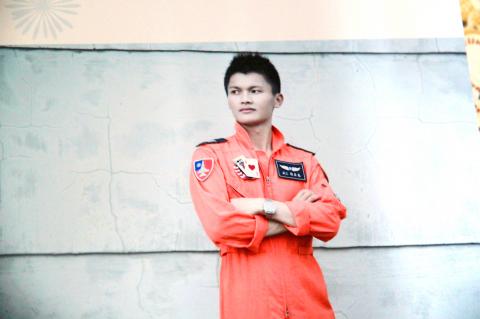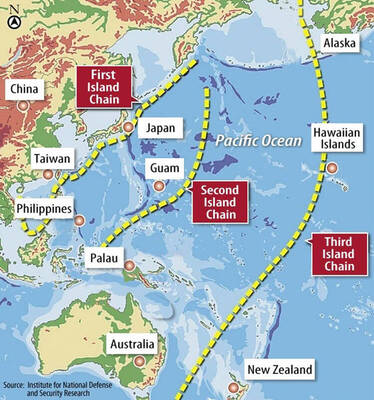Air Force Command Headquarters yesterday confirmed that Taiwanese pilot Major Kao Ting-cheng (高鼎程) has been found dead after his F-16 fighter jet crashed at a training base in the US state of Arizona.
The jet fighter crashed during a routine training mission at 9am on Thursday, a statement issued by Air Force Command said last evening.
Kao, 31, was a 2007 graduate of the Air Force Academy and had logged 865 flight hours. He was dispatched to the Luke Air Force Base in Arizona for F-16 fighter jet pilot training.

Photo: Copy by Cheng Hung-ta, Taipei Times
Kao was assigned to the 455th Tactical Fighter Wing at the Chiayi Air Force Base, where he served with distinction and won accolades from his superior officers, Ministry of National Defense officials said.
The cause of the crash is pending further investigation, the statement said, and the Republic of China (ROC) Air Force is to send officials to Arizona to take part in the investigation.
Kao was not able to eject before the single-seat fighter, which belonged to the ROC Air Force, crashed during the routine training mission, the ROC Defense Mission in the US said.
According to foreign media reports, US military officials said the pilot was conducting air-to-air combat maneuvers over Arizona when the plane went down.
Air Force Command said it was helping Kao’s relatives travel to the US.
The US Air Force said it has formed a flight safety committee to look into the incident.
Kao is survived by his wife and two children, including a child born late last year.
Kao Ching-lin (高青淋), Kao Ting-cheng’s father, said his only son had dreamed of being a pilot since he was in high school.
Despite Kao Ching-lin’s opposition, Kao Ting-cheng joined the Air Force Academy. On graduation, Kao Ting-cheng was given the opportunity to undergo a training program in the US because of his proficiency in English.
US Air Force Brigadier General Scott Pleus, commander of the 56th Fighter Wing at Luke, said Kao Ting-cheng had been in a training program for the past six months at Luke, which is a major pilot-training base for the US Air Force and foreign military services.
The crash occurred in rugged terrain about 16km southwest of Bagdad in Arizona’s Yavapai County.
The crash site, in a sparsely populated area, was located by a helicopter crew about four hours after the plane went down.
Bagdad is about 137km northwest of Luke, which is located in the Phoenix suburb of Glendale.
Pleus said an interim safety board has been formed to conduct a preliminary investigation into the crash.
Recent crashes involving F-16s from Luke included one on a training mission in southern New Mexico.
That pilot ejected safely.
An instructor pilot and a student pilot also ejected safely in June 2013 after their two-seat F-16 hit several birds during takeoff from Luke. The jet crashed in a farm field.
A US Air Force investigation report said the instructor pilot was at fault in that crash because he made a rapid climbing turn after the bird strike, robbing the plane of airspeed and the ability to recover and return to the base.
In July 2008, an Ohio Air National Guard pilot died when he blacked out and his F-16 crashed in western Arizona.
A US Air Force investigation board found that the 26-year-old pilot made an improper turn during a dogfighting maneuver in which high gravitational forces came into play.

The US government has signed defense cooperation agreements with Japan and the Philippines to boost the deterrence capabilities of countries in the first island chain, a report by the National Security Bureau (NSB) showed. The main countries on the first island chain include the two nations and Taiwan. The bureau is to present the report at a meeting of the legislature’s Foreign Affairs and National Defense Committee tomorrow. The US military has deployed Typhon missile systems to Japan’s Yamaguchi Prefecture and Zambales province in the Philippines during their joint military exercises. It has also installed NMESIS anti-ship systems in Japan’s Okinawa

‘WIN-WIN’: The Philippines, and central and eastern European countries are important potential drone cooperation partners, Minister of Foreign Affairs Lin Chia-lung said Minister of Foreign Affairs Lin Chia-lung (林佳龍) in an interview published yesterday confirmed that there are joint ventures between Taiwan and Poland in the drone industry. Lin made the remark in an exclusive interview with the Chinese-language Liberty Times (the Taipei Times’ sister paper). The government-backed Taiwan Excellence Drone International Business Opportunities Alliance and the Polish Chamber of Unmanned Systems on Wednesday last week signed a memorandum of understanding in Poland to develop a “non-China” supply chain for drones and work together on key technologies. Asked if Taiwan prioritized Poland among central and eastern European countries in drone collaboration, Lin

NO CONFIDENCE MOTION? The premier said that being toppled by the legislature for defending the Constitution would be a democratic badge of honor for him Premier Cho Jung-tai (卓榮泰) yesterday announced that the Cabinet would not countersign the amendments to the local revenue-sharing law passed by the Legislative Yuan last month. Cho said the decision not to countersign the amendments to the Act Governing the Allocation of Government Revenues and Expenditures (財政收支劃分法) was made in accordance with the Constitution. “The decision aims to safeguard our Constitution,” he said. The Constitution stipulates the president shall, in accordance with law, promulgate laws and issue mandates with the countersignature of the head of the Executive Yuan, or with the countersignatures of both the head of the Executive Yuan and ministers or

BACK TO WORK? Prosecutors said they are considering filing an appeal, while the Hsinchu City Government said it has applied for Ann Kao’s reinstatement as mayor The High Court yesterday found suspended Hsinchu mayor Ann Kao (高虹安) not guilty of embezzling assistant fees, reducing her sentence to six months in prison commutable to a fine from seven years and four months. The verdict acquitted Kao of the corruption charge, but found her guilty of causing a public official to commit document forgery. The High Prosecutors’ Office said it is reviewing the ruling and considering whether to file an appeal. The Taipei District Court in July last year sentenced Kao to seven years and four months in prison, along with a four-year deprivation of civil rights, for contravening the Anti-Corruption